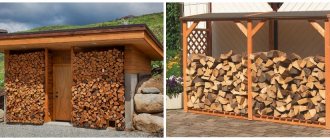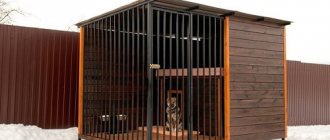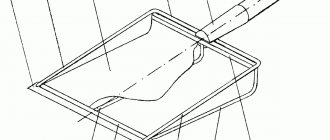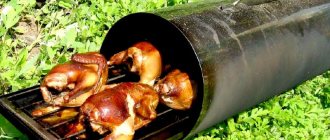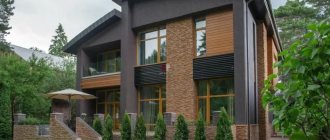Even animals want to have their own personal space. Sometimes houses have not only an aesthetic function, but also a practical one. It is customary to keep large dogs in spacious enclosures, but such housing should not be a simple cage. It is important to arrange the space so that the pet feels comfortable both in hot weather and in cold weather.
What types of enclosures are there?
Housing is classified according to several characteristics: stability of the structure, warmth of the walls (possibility of year-round living), location (street or indoor), size. The most common and correct division is by length of stay. There are 3 types of enclosures:
- Temporary - completely open structures made of mesh, often they can be folded and unfolded; do not have a foundation, roof, or insulation; used to restrict the freedom of large puppies, temporary foster care, segmentation of space for the dog during free walking.
- Closed – enclosures for permanent maintenance of average comfort; look like a structure of three solid walls and one transparent mesh; a booth and bedding are installed inside; it is important to organize a good canopy, spaciousness, and comfort for the dog; Suitable for large breeds with long, thick hair.
- Stationary (capital) - housing that is not just installed, but built without the possibility of transfer; the foundation is poured, the floor is laid out, 4 walls for the interior are separated, 1-3 additional transparent walls are organized; The enclosure is well insulated and creates the atmosphere of a cozy home.
Useful article on the topic: “Building a kennel ourselves: a guide to making and insulating a kennel.”
Outdoor aviary
It is imperative to build housing for those animals that need to be kept outside due to their size, long hair, need for constant activity or other physical characteristics. For such pets, an enclosure replaces a roof over their heads, a running track, and a cozy corner. In this case, you need a stationary, spacious cage equipped with a warm kennel, insulated floors and walls, covered from rain and sun, protected from the wind.
An outdoor enclosure is installed for animals that temporarily need to be evicted from their home (during renovations, for example, or quarantine). In this case, you can use a folding temporary or semi-closed one (depending on the length of the stay).
Often street housing is built for watchdogs, as a replacement for chain housing . Some breeds are prohibited from being kept on a leash, so a spacious enclosure of a closed or permanent type will be a good alternative. It is important to equip the cage with a place to sleep, bowls, and other amenities for the pet.
Aviary for the apartment
Apartment cage options also come in closed (an enclosure with 4 walls, a top bar and a bottom) and open (without a roof or floor) types. They are used to limit space for a pet in the event of a female pregnancy, the arrival of guests and other unusual situations.
Such a playpen is convenient for raising puppies and training them to use a tray; often a kennel is the only option for dogs that like to spoil things or mark corners in the absence of the owner. Such folding cages are taken with you to nature or the countryside to make it easier to control your pet on the street.
They make structures from plastic, metal, wood, tarpaulin (in the form of tents). The shape often resembles children's playpens or play areas. Sometimes cages are styled like a booth to make the pet feel comfortable.
It is not recommended to lock an animal in a closed space for more than 5 hours. At the same time, there should be enough free space inside, a drinking bowl, a bowl of food, a place for sleeping and a toilet.
Important qualities for home construction:
- Light weight but increased strength;
- Fixed door (either made of the same material, or a curtain with Velcro or ties);
- Movable roof that can be opened or unfastened;
- Removable bottom.
Depending on the size and activity of the animal, an enclosure is selected. For small breeds (Yorkshire Terriers, Chihuahuas) canvas tents are also suitable, but for puppies or adult Labradors, Laikas, Spaniels, a strong frame made of plastic pipes or metal mesh is needed.
Basic design requirements
Regardless of the variety, the enclosure must meet the following requirements:
- Safety . There should be no sharp objects inside, no cracks through which the dog can crawl out, or poorly secured objects.
- Zoning . If the structure is made for one animal, it is not necessary to delimit the internal space, while an enclosure for two or more dogs is better divided by partitions. This is especially true for those who are building a structure, for example, to house stray animals, since conflicts may arise between them, including over territory.
- Reliability . It is important to use high-quality materials that are resistant to mechanical stress and climatic conditions.
- Availability of necessary equipment . Inside, you definitely need to arrange a booth or an enclosed resting room, a feeder, bowls of water on a carefully secured frame, and a bed.
- Ease of care . The door to the enclosure should be the height of a person, so that when cleaning you do not have to bend over to get inside.
A well-designed enclosure is not only convenient, but also reliable. Source notperfect.ru
Choosing a location for a new home
For an apartment enclosure, choosing a location is an optional intermediate procedure, because the structure can always be moved. But even in this case, it is better to select an area where the animal can always watch the household.
There are several no's for an outdoor cage. Firstly, it is not installed behind the house, in the backyard, in a closed corner. The dog must watch people who enter and leave the house; they need human contact. Therefore, it is better to place the enclosure between the gate and the main entrance, not far from the path. It is not recommended to install the structure in lowlands where precipitation will flow; it is better to select or artificially create a small elevation.
Secondly, you cannot place a cage, especially without a roof or with a soft bottom, near a fence . Some animals are prone to escape; such placement of housing will become an unnecessary incentive. In winter, the pet will be able to push off from a snowdrift, and in summer, it will be able to dig a hole.
If you install an enclosure in a place with a strong smell (near a toilet, boiler room, bathhouse), this will disrupt the functioning of the dog’s olfactory receptors.
Depending on the climate, choose the north or south side so that the dog does not freeze in winter and does not get sunstroke in summer. It’s great when the enclosure is in the shade of a tree. It is better to place an open wall on the south side, this will reduce the risk of the passage being covered with snow in winter.
Preparatory work
Before you start building a house for your dog, decide on where to build it. You need to pay attention to a number of conditions:
— Avoid places with high noise levels - this has a very negative effect on the dog’s behavior;
— Place the dog enclosure within sight of the front door;
— There is no need to install an aviary in the low part of the yard. Firstly, water will collect there during precipitation, and secondly, the animal will not be able to assess the situation in the territory;
- Under no circumstances place the enclosure near foul-smelling sources, as your dog’s sense of smell may be affected.
For a high-quality enclosure, built without much difficulty, you need to prepare a drawing. This does not have to be a professional layout done according to all the rules; a detailed sketch will be quite enough. The main points that need to be indicated in the drawing: stationary or portable housing, delimitation of zones, sizes of various components of the enclosure and booth, place for the dog to eat, walking area and free access.
Calculation of the size of an enclosure for a dog based on basic parameters
The design of a cage is simpler than a kennel; two parameters are important for its construction - height and area. The first is determined by the height of an adult animal: standing on its hind legs, the pet should not rest against the roof. That is, the minimum height of the walls in the enclosure is 1.5 times the height of the animal. It is convenient if a person can enter the cage. Then you will need at least 1.6-1.8 m in height.
The area is also determined based on the height of the dog at the withers. A baby up to 50 cm will need at least 6 sq.m. , from 51 to 65 cm – from 8 sq.m. , more than 65 cm – from 10 sq.m. The width of the enclosure is taken out separately. It should be 1.5-2 times longer than the body length (from withers to tail) of the animal.
If you are planning a place for 2 dogs or a whole pack, the area is expanding (+3-4 for each dog), it is better to make a sectional division. The female needs a place to give birth (a vestibule, protected by walls on all sides, to protect newborn puppies from the cold), the male needs a spacious, strong kennel.
Outdoor enclosure 1. Beautiful and comfortable, but not without its drawbacks
The aviary can be harmoniously integrated into the design of your estate
I’ll say right away that I’ve never seen a more beautiful enclosure that fits harmoniously into the design of a country estate, either before or since. And yet, the builders did not take into account a very important detail - it does not have a walking compartment, which means that if the owners for some reason do not take the dog out on time, it will have no choice but to relieve its needs in the enclosure. This is a very significant drawback, however, it is typical for the vast majority of outdoor dog enclosures I have seen.
How to build a dog enclosure with your own hands
You can order a folding cage or spare parts for a stationary one on the Internet, or buy it at a hardware store or pet store. The average price for finished closed-type structures (street) is 10,000-80,000 rubles. Depending on additional elements and improvements, the price will vary.
But, with some materials, a talent for construction and competent drawings, you can independently build a cozy enclosure for a dog of any size. This option is not always fast and beautiful, but it is profitable and reliable.
It is not recommended to develop a complex design or use decorative elements (especially forged ones), as they can cause frequent injuries. Simplicity of design and ease of use are important. You can’t skimp on materials either. It is better not to use plastic or nails for outdoor cages (replace with screws and self-tapping screws). For permanent permanent housing, the foundation is being prepared. In addition, special attention is paid to the roof: it must be made sloping in the opposite direction from the exit so that precipitation can drain off.
Another criterion is a transparent wall. It is made from mesh or rods. The second option is always preferable, especially for large dogs. Iron rods are installed every 5-10 cm. Paws (claws) and muzzles (fangs) often get stuck in twists and nets.
Useful article: “Dangers of cold weather - signs, symptoms, prevention of colds in dogs.”
Required Tools
Depending on the type of enclosure, various materials and tools will be needed for construction:
- Shovel, hammer;
- Welding machine (if the frame is metal);
- Saw;
- Hammer, screwdriver, drill;
- Pliers (for bending gratings);
- Sandpaper (for wood processing);
- Containers for mortar and cement mixing (for foundations).
Aviary for a small dog
Playpens for small dogs are often apartment options; decorative breeds are not suitable for outdoor living. Therefore, it is easier to buy a small plastic enclosure. If you decide to build houses yourself, you need to arm yourself with:
- Wire;
- Pliers;
- A frame or elements for it made of the selected material;
- Door awnings, locks and latches.
For the tent version you will need thick fabric, threads, and Velcro. If metal rods are used as a base, then a welding machine is needed. For wood you will need a screwdriver with screws and a drill.
Selection of material and size calculation
The lightest and simplest frame is built from plastic pipes. This design is easy to fold and carry, but is not suitable for regular long-term maintenance. This type of material is good for a temporary playpen for puppies or as a territory boundary in specific situations. It is better to cover the enclosure with fabric curtains.
The second option is metal. They create a completely metal frame or in combination with wooden beams. You can use mesh or iron rods for transparent walls and doors. Often the enclosure is integrated into the furniture, using a cabinet, the bottom shelf of a wardrobe or a cabinet as the frame. Then the base of the enclosure is wood, and the front wall is built from available materials.
A home enclosure does not imply large-scale dimensions. The height is no less than the height of the animal at the withers. Small dogs are given playpens without a roof, then the walls must be of such a height that the pet cannot overcome them.
Drawings and photos
Step-by-step manufacturing instructions
The simplest option for a strong home enclosure is a wooden frame with metal inserts. First of all, prepare the base - a parallelepiped:
- Floor - according to area measurements (a rectangular section is knocked out of wooden boards, or hard plywood is used), it is better to nail 2-4 long bars to the bottom as legs;
- Flat boards (4-5 cm wide) are nailed to the sides of the finished floor (on the long part of the rectangle - 3 boards, on the short part - 2), it is important that the bars fit tightly at the corners;
- Metal rods with a diameter of 0.5-1.5 cm are driven between the boards or a solid mesh is attached; you can divide the height into 2 parts: cover half with whole plywood, and leave a “window” on top;
- A door is cut out of a single piece of wooden board so that it fits tightly across the width between the boards;
- A place for a window from mesh or rods is also cut out in it;
- The hinges are attached so that the door opens outward;
- The roof is made at will, by analogy with the floor (several flat boards or a whole flat beam);
- The bottom is covered with a lounger, holders for bowls are attached;
- It is better to varnish the frame.
Video tutorial for making a small indoor aviary
Aviary for a medium breed dog
Depending on the place of residence of the animal, materials and construction scheme are selected. For apartment-kept dogs, an enclosure of the previous type (as for small pets), with adjusted dimensions, is suitable. Of course, a plastic frame and a building without a floor and roof will not suit an active medium-sized dog. If your pet is kept outdoors, he needs a spacious enclosure of a closed or stationary type with 3 blank walls and one transparent one.
Selection of material and size calculation
A wooden frame is ideal for an outdoor enclosure. A simple design - a parallelepiped with a sloping roof and a small kennel inside. Of course, you can build an enclosure with two open walls or a completely unprotected dwelling, but with an insulated, equipped booth . An option for a permanent stationary enclosure is a stone house with a foundation.
Depending on the breed, the size of the cage varies. Some small dogs do not need to move much; 5-6 sq.m. is enough (excluding kennel). Laikas will need a large space, it is better to organize several zones for them, open ground is prohibited. Spitz are characterized by a craving for freedom, they make tunnels. Height – 1-1.2 m minimum.
Drawings and photos
Step-by-step manufacturing instructions
There is a small enclosure based on the principle of a box. The floor is made: 2 long wooden beams are installed in parallel, long dense boards are placed on them, attached with screws or bolts so that the dog is not injured by nails. The floor must be leveled and varnished. A frame is installed around the perimeter. The boards are nailed at the corners of the floor and in the middle of the long back wall.
The next step is building walls . Whole square boards and lining are used. First, they are impregnated with drying oil and secured with screws to the vertical frame. Install 3 blank walls. A clapboard is attached on top to protect from the wind. In the last stage, the structure must be varnished.
The outer open wall is made up of individual rods or a ready-made lattice; the use of a mesh is not recommended. Next, the internal kennel is installed or a ready-made one is installed. It should be located in the deepest corner of the enclosure.
For the roof, a sloping wooden frame is assembled from bars, longitudinal boards are attached, and covered with insulating insulation. The top layer is roofing material; you can use varnished wood, slate, or corrugated board. It is important that the tilt is in the opposite direction from the door.
the door in the lattice part, purchase a ready-made one and hang it on the hinges. The last step is to set up bowls, place the bed in the kennel, and possibly insulate the walls for the winter.
Video tutorial on making an enclosure for a medium-sized breed
Aviary for a large breed dog
For permanent residence, a large animal needs a spacious and multifunctional enclosure with a winter road, an open area and a small platform where bowls and a summer bed are installed. In this case, only a fundamental approach and permanent construction using several types of materials are needed.
Selection of material and size calculation
To build a house for a large pet, you will have to spend money on several types of materials. Firstly, you will need cement to pour the foundation, and secondly, wood for the walls of the winter road and the frame of the platform. Often, breeders save money and choose ready-made mesh instead of individual iron rods. It's cheaper, but dangerous for the dog, who could get caught and get hurt.
The choice of brick walls and stone floors is not the best. This material is cold and does not warm well. Metal sheets should not be used; they heat up too quickly, and in winter they freeze and draw out heat.
Big animals need a big house. When space is limited, the pet can become aggressive, uncommunicative, and withdrawn. Therefore, the enclosure must be at least 4 meters long and 2.5-3 meters wide. The dimensions of an adult dog are taken into account: height at the withers and body length. It is better to choose a height equal to the height of the owner.
Drawings and photos
Step-by-step manufacturing instructions
General plan for building a multifunctional enclosure:
- Construction of the lower part: pouring the foundation according to the full size of the future cage (taking into account the platform and winter road, you can leave a section of soil); a mortar screed of 40-60 mm with a slight slope is poured. The floor for the platform or flooring is half of the enclosure - a frame made of timber and a flooring made of polished boards screwed in with screws.
- A frame for the winter road is installed from boards or wooden piles. A blank wooden wall is being built around the perimeter of the deck, 4 walls of the winter road. Can be insulated with ecowool. The resulting structure is covered with a sloping roof.
- The remaining part of the enclosure is covered with a metal frame made of horizontal and vertical rods. A metal door with a latch is attached. It is better to weld grooves for a padlock.
- The wood must be sanded and varnished.
Video tutorial for making a large enclosure
Important parts of the design
Almost any enclosure consists of the following elements:
- Base . It is mandatory for outdoor structures, since it provides maximum reliability, and also allows you to raise the enclosure above the soil surface, which is important for the most effective ventilation and protection from moisture. Most often, a columnar foundation is made for an enclosure, but for a brick or block structure a more durable structure is needed, so a monolithic strip is installed for it.
- Walls . It is necessary that at least 2 out of 4 are deaf so that the animals kept inside do not feel uncomfortable. They can be made of brick, half-block, classic block, made of wood, plywood. 1 or 2 walls should have mesh inserts or be made completely mesh.
- Floor . It must be made of non-slip materials, carefully insulated and waterproofed.
- Roof . Most often it is made of a single slope, the materials are corrugated sheets, soft roofing, metal tiles.
- Entrance . If the enclosure is intended for large breed dogs, it is worth installing a full door, preferably a metal one.
Scheme of arrangement of a standard enclosureSource dalmspb.com
Photo examples of enclosures made of different materials
Of course, it’s easier to order a ready-made enclosure or contact specialists. It is difficult to erect a serious building on your own; only an experienced owner or builder can handle it. It is important that the home is suitable for the pet in size, cozy, warm, protected from cold and heat.
4 / 5 ( 2 voices)
Reticulate
The mesh version is quite practical, because it is easy to manufacture and does not require any special costs. Also, the metal will last quite a long time. Consumables will require metal mesh and reinforcement rods with a diameter of 3 or 4 mm. The first step is to decide on the shape and size of the enclosure.
If it is a regular rectangular or square structure, then it can be assembled from separate modules. To do this, a frame for each wall is prepared from durable steel wire. The rods are passed through the holes of the mesh to keep it taut. You can do it differently and tie the mesh with wire to the finished frame.
Once all the walls are ready, they can be connected together with wire or suitable bolt clamps. You can do without a door, because the pet will be easy to reach through the top, which is open. To give the structure a more presentable look, you need to paint it in the desired color. Instead of wire, an aluminum frame can be used for the enclosure, as shown in the photo above.
Floor or soil?
Purchased enclosures are often simply placed on the ground; The dog relieves its physiological needs on it. The floor of the enclosure needs to be cleaned of traces of its vital activity, but the dog is able to dig a hole in the ground and leave the enclosure. How can we be here?
Firstly, northern dogs dig the ground in exceptional cases. Their digging reflex is very weak, because... They have permafrost in their homeland. If a husky, husky or labrador is regularly walked or let out on patrol, you don’t have to be afraid of undermining from them. Secondly, at one time J. Darrell came up with a way to develop toilet skills in almost any mammal, even a wild African pig:
- Prepare a small enamel vessel of suitable size for the dog’s latrine: a basin, a foot bath with a sealed drain, a large bowl.
- When building an enclosure, away from the booth and feeder (see below), a cutout is made in the floor for installing a toilet bowl.
- The cutout for the toilet is temporarily sewn up with plywood.
- During the period of training to the enclosure, the dog is given the opportunity to relieve itself wherever it wants.
- When it gets used to it, a pile of fresher droppings is taken for temporary storage.
- The enclosure is being thoroughly cleaned.
- They remove the plywood, put the toilet in place and fill it halfway with sand.
- They put the saved lump of droppings in the toilet and let the dog into the enclosure.
This method works flawlessly: after all, animals mark their territory with urine and excrement. Now the dog will only go to the toilet in a big way. The sand in it is needed to satisfy the instinct to bury waste; it needs to be changed from time to time.
Note: kennel for burrowing dogs, e.g. fox terrier must have a floor.
Feeder
Making a dog feeder in the enclosure rotating at floor level (on the left in the figure) in order to demonstrate your mechanical skills is a serious mistake. A funny thing provokes the animal to play with it, which is dangerous for the dog. The feeder should be made folding with the bottom edge approximately at the height of the lower edge of the dog’s chest, as on the right in Fig.
Feeders in dog enclosures
Roof
The roof of the dog enclosure must have a gap for ventilation. Walk in on a hot summer day with a gentle breeze from the yard onto the veranda. Is it stuffy there? Now imagine that you are covered in fur from head to toe. Let us repeat once again: heat and stuffiness are much more harmful for a dog than bitter cold.
As for what to lay the roof of the enclosure from, here is the basic rule: the roofing material should not resonate in the rain or wind. A dog's hearing is as sensitive as its sense of smell; Frequently repeated sharp sounds can damage it. The best materials for the roof of an enclosure are sound-absorbing: roofing felt, soft tiles. It’s easier to lay them on the sheathing.
Note: the scraps of timber from the construction of the wooden enclosure came in handy - they were used to create a ventilation gap under the roof. The sheathing is of the usual type, but it won’t hurt to insulate it. Not for the winter, but for the summer, so that the roof, heated by the sun, does not radiate heat downwards as much.
Lattice
Cross members from the same rod must be welded to the grid of the enclosure made of rods with a vertical pitch of 1-1.3 m. Usually one cross member is placed at half the height of the rods. In an enclosure for a shepherd dog, it is better to install two crossbars, respectively. by reducing the installation step. The German Shepherd is not the champion of strength among its relatives; the Caucasian and Central Asian are stronger. But an adult male German Shepherd pushes apart 10x10 bars 1.5 m long.
Special Husky Cases
This intelligent, loyal and disciplined dog is becoming increasingly popular. If reindeer-hunting huskies do not make watchmen, and hunting dogs are produced occasionally (although all of them are outstanding), then the husky can be called a jack-of-all-trades dog. However, a husky enclosure should have a number of features.
First, the enclosure for a husky needs a height of 2.2 m. The husky dog is a very jumping dog; in their homeland they need it so much to look around over the endless snow. A husky jumps almost like a poodle, and he, for your information, jumps from the floor onto the cabinet without a run.
Secondly, the bars of the husky enclosure should be made not from rods, but from mesh. Jumping, the husky clings to it. If the bars of the husky's enclosure are made of twigs, then it will be impossible for the dog to do the physical exercises it needs. Finally, in mid-latitudes and to the south, it is better to have a husky enclosure facing north, northeast and northwest.
About the grid
Dog enclosures with mesh bars
A mesh lattice instead of rods is also suitable in an enclosure for dogs of other breeds. It is better to place a wicker mesh grille in the enclosure, pos. 1 in Fig. on right. For a husky, this is all the more good because the wires of the woven mesh are bent in a zigzag and are easier to cling to. But welded mesh will also work, pos. 2. In both cases, the wire diameter is from 4 mm, and the mesh is 10x10 cm for large dogs and from 5x5 to 7x7 for small ones.
It is not advisable to use chain-link mesh to lattice enclosures: even very calm dogs often injure their paws on it, and hair plucked by chain-link is a common occurrence in such enclosures. By the way, chain-link is safe for a husky, this dog is so smart. She is too smart for a chain-link enclosure: she unravels the joints, tears them off the frames and leaves the enclosure in an hour and a half. The only time an enclosure for a dog made of chain-link mesh is justified is when its area is more than 20 square meters. m, and the dog is a guard breed, i.e. very disciplined, and trained by a good dog handler.
Useful tips
Some recommendations can provide practical assistance in building an enclosure for your pet:
- the enclosure should be located away from sources of various noises;
- all enclosures should be mounted on a small hill;
- dimensions matter: a spacious object will be too cold, the dog may freeze;
- a combination of forged metal and boards is a good working option;
- if it is difficult to make an aviary with your own hands, you can purchase it at a specialized store;
- Nails and materials containing toxins (chipboard) should not be used for fastenings;
- if the dog is too active, additional structures should be built inside the enclosure (jumping simulators, benches, etc.);
- it is forbidden to build an enclosure under a house from the roof of which an avalanche of snow may fall;
- It is better not to build an enclosure close to the fence;
- you cannot build an enclosure in closed areas where there is not sufficient visibility;
- for a large dog, two layers of mesh are required;
- when drawing a drawing, you should have a plan diagram of the site at hand;
- The feeder is installed simply: you select the place where it should be present;
- It is rational to make the feeder rotary, for this you should use a fragment of the wall;
- to train a dog to an enclosure, you should start feeding it in a new room;
- It is recommended to accustom the dog to the following commands: “Let’s go home”, “Aviary”;
- After building the enclosure, it is recommended to lock the dog in the enclosure for 5–10 minutes, give him his favorite toys, the animal should get used to it.
To learn how to make an enclosure for a dog with your own hands, see the following video.
Mistakes to Avoid
After building an enclosure, various problems may arise. It is easier to avoid mistakes if you know about possible difficulties in advance. Recommendations from those who have already built enclosures:
- forged decorative elements are beautiful, but can injure the dog. If possible, it is better to abandon them;
- The location of the enclosure should be chosen based on the view that opens. The more territory the dog sees, the more interesting it will be for him;
- When installing a door, it is important that it opens inward. Otherwise the dog will be able to knock it out. It is also necessary to install a lock or deadbolt;
- When using wooden boards, it is advisable not to nail them, because over time they will become loose and come out, which is dangerous for the dog.
The doors to the enclosure are installed last.
Wood
Making a wooden enclosure is even easier than making a metal one. To implement the project of such an enclosure, you will need wooden blocks with a section of 40 by 20 mm. A drawing is drawn up in advance indicating the dimensions of the structure.
According to the drawing, timber blanks are cut, which will be used for the lower and upper trim, as well as for the racks. First of all, two bases of a rectangular or other shape are assembled. Four main posts are screwed to the bottom one, which are located in the corners. The top trim is fixed to these posts.
After this, wooden planks are mounted at the same distance, which will act as walls. If the enclosure is located near a wall, then it makes sense to make the back wall solid from fiberboard or OSB. This will make it more difficult for your pet to damage the finish. If the structure is more than 80 cm high, then it makes sense to make a small door, as can be seen in the photo above. A video about the construction of another version of the enclosure is below.


